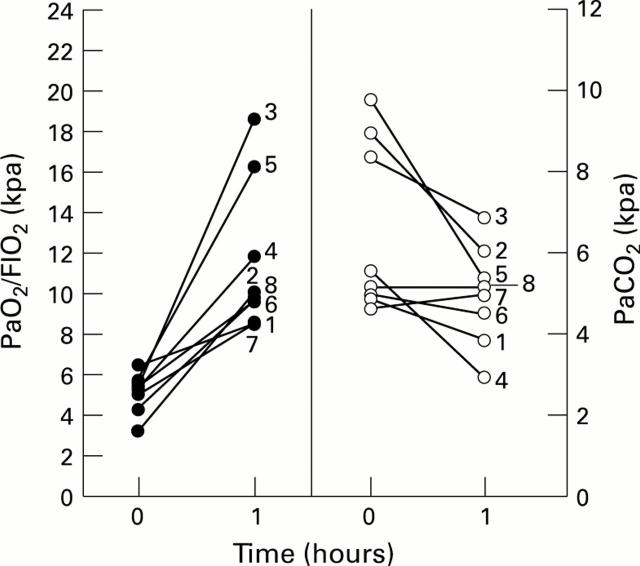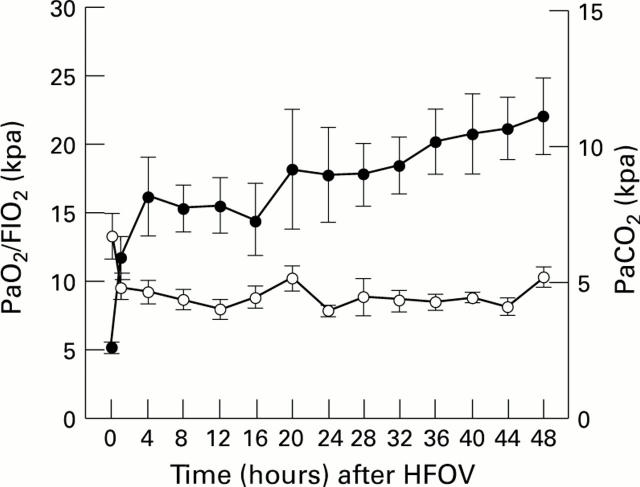Abstract
AIMS—To describe the short term effect of high frequency oscillatory ventilation on infants with severe abdominal distension who could not be conventionally ventilated. METHODS—Eight infants (25 to 38 gestational weeks, birthweight 600-3200 g, postnatal age 1 to 190 days) with a variety of intra-abdominal pathologies, resulting in severe abdominal distension and failure of conventional ventilation, were studied. RESULTS—The oxygenation status of all infants significantly improved within an hour of changing from conventional to high frequency oscillatory ventilation. Infants who were hypercapneic on conventional ventilation also showed a reduction in PaCO2. As a group, the mean (SD) PaO2/FIO2 improved from 4.99 (0.98) kpa to 11.55 (3.8) kpa (P = 0.002), and the PaCO2 from 6.48 (2.12) kpa to 4.89 (1.22) kpa (P= 0.028). These improvements were sustained throughout the next 48 hours. CONCLUSION—High frequency oscillatory ventilation seems to be an effective rescue measure for infants with respiratory failure secondary to increased intra-abdominal pressure. Keywords: abdominal distension; high frequency oscillatory ventilation; respiratory failure.
Full Text
The Full Text of this article is available as a PDF (96.9 KB).
Figure 1 .
Changes in oxygenation efficiency index (PaO2/ FIO2;•) and PaCO2 (∘) one hour after the start of high frequency oscillatory ventilation.
Figure 2 .
Group means (SEM) of oxygenation efficiency index (PaO2/FIO2;•) and PaCO2 (∘) immediately before (zero hours) and 48 hours after the start of high frequency oscillatory ventilation. Both parameters were significantly higher than those at zero hours (one way repeated measures: ANOVA oxygenation efficiency index P<0.0001; PaCO2 P= 0.0162; pairwise multiple comparison using the Student-Newman-Keuls method P< 0.05 for both parameters).
Selected References
These references are in PubMed. This may not be the complete list of references from this article.
- Bartholomew K. M., Brownlee K. G., Snowden S., Dear P. R. To PEEP or not to PEEP? Arch Dis Child Fetal Neonatal Ed. 1994 May;70(3):F209–F212. doi: 10.1136/fn.70.3.f209. [DOI] [PMC free article] [PubMed] [Google Scholar]
- Clark R. H., Gerstmann D. R., Null D. M., Jr, deLemos R. A. Prospective randomized comparison of high-frequency oscillatory and conventional ventilation in respiratory distress syndrome. Pediatrics. 1992 Jan;89(1):5–12. [PubMed] [Google Scholar]
- Clark R. H., Gerstmann D. R., Null D. M., Yoder B. A., Cornish J. D., Glasier C. M., Ackerman N. B., Bell R. E., Delemos R. A. Pulmonary interstitial emphysema treated by high-frequency oscillatory ventilation. Crit Care Med. 1986 Nov;14(11):926–930. doi: 10.1097/00003246-198611000-00002. [DOI] [PubMed] [Google Scholar]
- Clark R. H., Yoder B. A., Sell M. S. Prospective, randomized comparison of high-frequency oscillation and conventional ventilation in candidates for extracorporeal membrane oxygenation. J Pediatr. 1994 Mar;124(3):447–454. doi: 10.1016/s0022-3476(94)70374-4. [DOI] [PubMed] [Google Scholar]
- Delemos R. A., Coalson J. J., Gerstmann D. R., Null D. M., Jr, Ackerman N. B., Escobedo M. B., Robotham J. L., Kuehl T. J. Ventilatory management of infant baboons with hyaline membrane disease: the use of high frequency ventilation. Pediatr Res. 1987 Jun;21(6):594–602. doi: 10.1203/00006450-198706000-00018. [DOI] [PubMed] [Google Scholar]
- Miguet D., Claris O., Lapillonne A., Bakr A., Chappuis J. P., Salle B. L. Preoperative stabilization using high-frequency oscillatory ventilation in the management of congenital diaphragmatic hernia. Crit Care Med. 1994 Sep;22(9 Suppl):S77–S82. doi: 10.1097/00003246-199422091-00008. [DOI] [PubMed] [Google Scholar]
- Randomized study of high-frequency oscillatory ventilation in infants with severe respiratory distress syndrome. HiFO Study Group. J Pediatr. 1993 Apr;122(4):609–619. doi: 10.1016/s0022-3476(05)83548-6. [DOI] [PubMed] [Google Scholar]
- Varnholt V., Lasch P., Suske G., Kachel W., Brands W. High frequency oscillatory ventilation and extracorporeal membrane oxygenation in severe persistent pulmonary hypertension of the newborn. Eur J Pediatr. 1992 Oct;151(10):769–774. doi: 10.1007/BF01959088. [DOI] [PubMed] [Google Scholar]
- deLemos R. A., Coalson J. J., deLemos J. A., King R. J., Clark R. H., Gerstmann D. R. Rescue ventilation with high frequency oscillation in premature baboons with hyaline membrane disease. Pediatr Pulmonol. 1992 Jan;12(1):29–36. doi: 10.1002/ppul.1950120108. [DOI] [PubMed] [Google Scholar]




